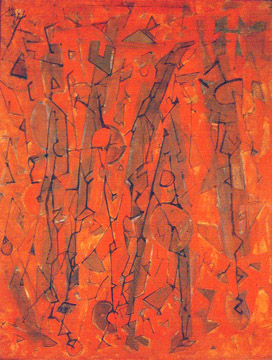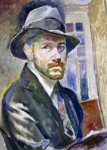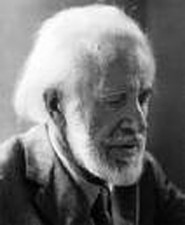
Mark Tobey
American , 1890-1976
Pacific Rhythms, 1948
tempera on paper mounted on board
26 × 20 1/4 in.
SBMA, Museum purchase, First Pacific Coast Biennial Fund
1955.19

Self Portrait
"Our ground today is not so much the national or the regional as it is the understanding of a single earth. Ours is a universal time and the significance of such a time points to the universalizing of the consciousness and the conscience of man. It is in the awareness of this that our future depends unless we are to sink into a universal dark age." -Tobey
RESEARCH PAPER
Mark Tobey is an independent painter who cannot be identified with any group. Although his work developed at the same time as Jackson Pollock's, and like Pollock his painting actively covers the entire surface, he is not an Abstract Expressionist. Tobey's work is small in scale (like Paul Klee's) and while it may be non-objective in its effect, it is still an analysis of the real world and of nature.
Tobey was a member of the mystical Baha'i faith which affirms the basic unity of all men and the ultimate concordance of all religions.
Tobey travelled widely to the Near East and to Mexico. In 1934 he visited the Far East - Japan and China . In Japan he stayed in a Zen Buddhist monastery and converted to Buddhism. In China he studied calligraphy - the true purpose of his journey. This journey had a profound effect upon Tobey's painting technique - "white-writing" - in which he covers the surface with an intricate network of signs. Tobey, however, resists being called an Orientalist. As he told the art critic, Henry Seldis, in 1958, "Some critics have accused me of being an Orientalist and using oriental models. I knew (when in Japan and China struggling with their Sumi brush technique) that I would never be anything but an Occidental." Nonetheless, Seldis concludes, and Tobey agrees that it was in the orient that he got the calligraphic impulse which carries his work.
Tobey's brushstokes articulate the entire surface (just like Pollock whose work he reinforced rather than influenced). The rhythmic brushmarks give a felling of infinite possibilities, of destabilization. It seems certain that they will rearrange themselves - but it seems equally certain that any rearrangement will assume harmonious balance.
Earlier in his career Tobey painted in a figurative style. These works underscore a common bond of humanity, and like his later non-objective work they avoid color and emphasize the complexity of organic life. In.the 1940's Tobey completely rejected formal composition and adopted a nervous, energetic brushstroke, more or less autonomous in feeling and in impulse which became his characteristic style.
Tobey has been a huge influence on French art. (He lived in Switzerland) and on Northwest artists Arthur Okamura, Morris Graves and Carl Morris.
As time progressed, Tobey's brushstrokes became smaller and smaller, his surfaces pulsated with organic movement and rhythm. His small canvases became tangled webs of lines in atmospheric space. One critic compared them to the tracery of stars on the night sky. Another said that its pale grisaille presence became an intricate network of signs.
Thus Tobey evades our efforts at definition. His art is, simply, like poetry - to which it bears certain obvious similarities- gently and finally itself.
Prepared for Picasso to Christo by Margie Chelini, SBMA Docent Council, December, 1993

Undated photo of Tobey
